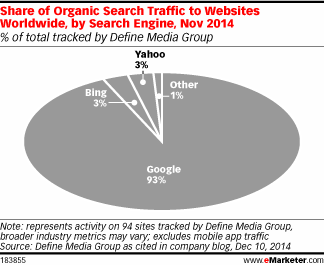 Google has announced that on April 21, 2015, Google’s mobile ranking factors will not only label your site as mobile-friendly, but will also use mobile-friendliness to determine if your site should rank higher in the search results. According to Google’s Webmaster Central Blog:
Google has announced that on April 21, 2015, Google’s mobile ranking factors will not only label your site as mobile-friendly, but will also use mobile-friendliness to determine if your site should rank higher in the search results. According to Google’s Webmaster Central Blog:
“Starting April 21, we will be expanding our use of mobile-friendliness as a ranking signal. This change will affect mobile searches in all languages worldwide and will have a significant impact in our search results.” (Bold emphasis ours.)
This makes official what we already know: search engines really care about mobile. We know the top priority for search engines is the user, and the ease of use and quality of results that searcher experiences. With the increased usage of mobile devices in everyday life, it’s no surprise that people are demanding a better experience when they search on mobile devices. Google has responded by apparently preferring responsive-designed websites over non-responsive ones in mobile search, and mobile-friendly sites are tagged as such in search results. But with this coming algorithm change, Google is making a much stronger statement.
What’s at stake?
Starting on April 21 we expect to see only mobile results impacted by this update. Estimates conclude that over 50% of all searches done on Google are from mobile devices. While this figure is unsubstantiated, a significant amount of traffic online is through mobile means. This means many sites could see a negative impact if they aren’t prepared. It may be that desktop results will eventually be impacted by mobile as well, but that’s speculation at this point.
The algorithm is set to launch both in the U.S. and worldwide in all languages on April 21. If prior updates have taught us anything, it’s that these updates will slowly be rolled out with the possibility of inconsistencies when implemented internationally.
“Mobilegeddon,” as one Search Engine Watch article called it, is anticipated to have an even greater impact than Panda or Penguin. Digital marketers clung to the words and insight shared by Zineb Ait Bahajji, a member of Google’s Webmaster Trends team, when she spoke at SMX Munich and stated as much. While these claims are often simply opinions by Google stakeholders, this one caused a stir in the community. All SEO professionals recommend that you should prepare well for this change.

The data on Google’s dominance varies, but the numbers are all big
In a study of Q3 2014, Merkle | RKG (a search and digital marketing agency) reported that Google increased its share of organic search visits in the US to 83%. Casting a wider net, Define Media Group tracked traffic to 94 sites across various industry verticals between January and November 2014 and found that Google accounted for a whopping 93% of online and mobile web organic search traffic worldwide. (Read more about the study at eMarketer.)
What’s Google’s end game?
Google and the other search engines have the ultimate goal of satisfying search users. Sure, they have other objectives in mind, but without those searchers there would be no monetization possible. That was the reason for Panda (which looks for high-quality content) and Penguin (which looks for spammy actions). As users shift their behaviors, search engines must anticipate and meet changing expectations in order to retain or gain market position.
One such accommodation is in the world of mobile. Today, more users access the Internet using mobile devices than any other type of device. That’s astounding! It makes sense that search engines would need to shift their algorithms to facilitate satisfactory mobile experiences. This update does just that, and Google sees it as a necessary shift in the way they process information at the mobile search level.
What can you do to get ready?
You’ve still got a few weeks before the April 21 deadline approaches. Here’s what you should do to prioritize your next steps of prepping your site for mobility.
Week One: Mobility Optimization
First, review our Mobile Search Engine Optimization Best Practices document and ensure you and your team are following these guidelines. This best practices guide was put together to help you start from scratch on understanding and implementing mobile best practices.
Next, understand exactly how much mobile traffic you’re receiving by reviewing Google Analytics or another web analytics platform. This is the amount of traffic that will be affected, if negatively, after April 21. How much effort are you willing to put in to ensure these visitors keep coming to your site?
Run your site through a Mobile-Friendly Test in addition to checking Google Webmaster Tools. Common errors in Google Webmaster tools include:
- Touch elements too close: Buttons and other elements should be spaced apart for easy navigation.
- Content not sized to viewport or viewport not configured: A viewport controls how a page is displayed on mobile. Without it, mobile devices will render the page at desktop screen width, scaled down to fit the screen. Setting a viewport gives control over the page’s width and scaling on different devices.
- Small font size: Make the font sizes readable on mobile and make sure there’s enough space between lines of text to ensure legibility.
Establish the elements within your control that you can fix. Meet with your development team quickly to understand what you can and can’t change. How much time will it take to complete? Is it an important element to usability on mobile? Will they be able to attend to it before the deadline? Establish this in the first week of your mobility optimization.
Week Two: Mobility Optimization
Allocate efforts (whether from your own internal team or external teams) to get SEO best practices addressed for mobility. Review the needs from our list of best practices, as well as from Google Webmaster Tools and the tests you run. After speaking with your dev team or the SEO agency helping you address the issues, you’ll get a better sense of where you are and how much is left to do.
Remember to stay on task and get your team working effectively and efficiently. Time is of the essence and efficient project management will be important to seeing mobile optimization through to completion.
Week Three and Beyond
Continue preventive checks and execute fixes to limit the negative impact of mobile updates. Don’t forget about mobile readying your email too. Although not necessarily a ranking factor, it’s an important, complementary item to consider while you’re working on mobility. Run Google’s Mobile-Friendly Test again to check for errors and try out other tools such as those listed below. We’ve found that some tests show inconclusive results and when re-run do not update to give you a passing grade. As with any third-party tool there will be some issues, but use your gut and what you know as best practices to get you through.
Mobile-friendly tests:
With the resources and information above, it’s our hope that you’ve got a growing list of next steps to help you prepare for Google’s mobile search update.
Venturing into the world of multiple screens sizes and media queries? Fear not! Our on-demand webinar, Responsive Design: 10 Do’s and Dont’s for Web Pages and Emails, will walk you through the best practices for creating mobile friendly digital marketing assets.
Need some additional assistance? Use our comment section to ask us those all-important questions as you take the necessary next steps.
